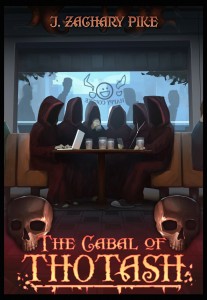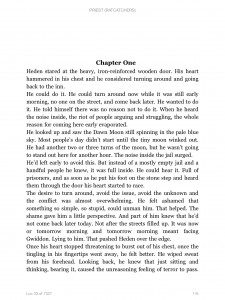What do you want this time? Didn’t I tell you not to bother me again tonight? I’ve tucked you in, kissed you, and even brought you a glass of juice. What else could there be? You want a story? Why do you think I should tell you a story? Well, your mother isn’t here, and she and I do things differently. Now to bed with you.
A what? Under where? How did you get an idea like that? Your mother told you. I should have known! Look, boy, there are no goblins, pooka, or boggarts under your bed. Now that we’ve settled that argument, you can go to sleep. They wouldn’t be under your bed because it’s too small for them. Besides, why would they bother with a skinny little boy like you?
Very well, if I tell you a story, will you promise to go to sleep? Promise me. That’s very good. Now promise again, and let me see your fingers. Good, now if you go back on your word I’ll never believe you after.
Many years ago…
What do you mean I’m not doing it right? I told you: I do things differently than your mother. Fine! I’ll do it the right way.
Once upon a time… Is that better? Good… there was a young man who made his profession as a pickpocket. Yes, right here in Dublin. Yes, he knew what would happen if they caught him. I’m getting to that.
He was so great a pickpocket, he’d never been caught in all his days. The skill with which he worked his hands was so grand, that when he walked down the street money seemed to leap out of people’s pockets and into his. He was so rich, he did not live on the street or in a shack like most thieves. No, he lived in a great manor house, and never wanted for anything.
If you keep interrupting me, I’m going to stop telling this story and leave. Yes, I know the goblins are still under there. Yes, I know exactly what they’ll do to you. No, your mother won’t miss you. I’ll get a street urchin and dress him just like you. She’ll never know the difference. Yes, I’m serious. Now quiet, or I won’t finish.
One day the pickpocket, never you mind what his name was, was walking down the street when he noticed his belt felt a bit lighter than it had a moment before. He looked down, and to his amazement, his purse was gone. Yes, gone. Just like that!
He looked around and saw a gypsy girl counting the coins out of a purse that looked very much like his own. That’s because it was his purse. You’re a bright boy. You don’t need me to explain everything to you.
Well, the pickpocket circled around and got in front of this gypsy girl and stopped her. No, I don’t know what her name was either. Why do you think I know these people? It’s only a story, which I won’t finish if you keep pestering me with silly questions.
The pickpocket said to the gypsy, “That’s my purse you hold.” When she tried to run, he stopped her and continued. “I don’t want to take you to the constable or throw you in the stocks. I can see that you’re at least as good a pick pocket as I.” At that he held up his purse, which he had taken from her, unaware. “I propose that we form a partnership between us, sweep through this city, and pick it clean.”
Being a gypsy, she saw the chance for wealth. And, as well we know, gypsies are known for their love of any task that earns easy coin. Her deep brown eyes sparkled with greedy delight and she accepted. No. Your mother’s eyes are green. More like your grandmother’s.
Over the next few years they swept through Dublin. Not a single man nor woman escaped the two thieves on their quest. Soon they no longer lived in his manor house, but in a grand palace that was the envy of many kings and queens. I believe that it still stands to this day. No we can’t go see it tomorrow, maybe some day when you’re older. I don’t know when that will be. Now let me finish.
One night as they feasted on a great supper, the Gypsy girl looked up. “We should marry,” she said to the pickpocket. “If you and I were to wed, we might sire a whole race of pickpockets. Our children will sweep through all lands, and know the riches of the world.”
Since the pickpocket was a stout young man, and she was a pretty young lady, he agreed. Soon after, they were married. About a year later she gave birth to a handsome baby boy.
What? Where do babies come from? Boy, that is another story for another day. A day when you are much older. I’ll tell you that the next time you mother goes to visit her sister, which won’t be for a very long time if I have any say in the matter. Are you going to let me finish? Good!
When the mid wife handed the child over, the happy couple looked at their new son. Upon first glance, they saw the grandest child ever born in Ireland. Then they saw a problem with the boy. His right arm was paralyzed up against his chest. They didn’t know why, and neither did the midwife. All they knew was, his right hand was balled into a fist, and his arm could not be pried from his body.
What do you think they did about it? They were rich. What do most rich people do when they get injured or sick? That’s right. They seek out a healer, and that’s what the pickpocket and the gypsy did. The two of them gathered their massive fortune and traveled all throughout the lands seeking a healer or surgeon to aid their child. Yes, they loved him so much they were willing to pay a thousand surgeon’s prices.
I do love you that much. Unfortunately, we haven’t got that much money. Quiet now, or I’ll spend some money to find a healer to cure you of your voice.
For a year they traveled, but to no avail. Not one of these men of medicine could tell them of a way to aid their son. Finally, with little hope they returned to Dublin. There was only one man they had not seen: Magnus Maxwell, Surgeon and healer unparalleled. Yes, the same Magnus Maxwell that comes for supper every so often.
After many tests Magnus, like all the others, could not tell what ailed the boy. He did, however; notice that the child watched his every move with keen eyes. Magnus then brought forth his gold pocket-watch, and waved it before the child’s eyes. Yes, like the watch I have.
As the watch waved, a bit of sunlight caught it, and the boy smiled a great, beaming smile as only an innocent babe can.
Then a miracle happened. The boy’s arm started to reach toward the pocket watch. His arm moved slowly, ever so slowly. Because he’d never used the arm before, the muscles strained. A moment later, the child could almost just barely touch the watch. As the boy opened his fingers to take it, the midwife’s gold ring fell from his grasp.
Where did the ring come from? You’re a bright boy. I’m sure you can figure it out for yourself. No I won’t just tell you. Now, you’ve been tucked in, kissed good night, had your juice, and heard a story. I don’t want to hear any more about the goblins or boggarts. Good night to you, boy.
Good night.




 Amazon US
Amazon US




